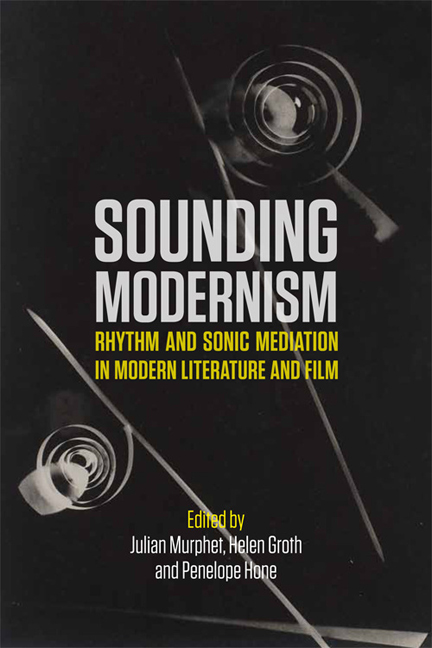Book contents
- Frontmatter
- Contents
- Acknowledgements
- 1 Introduction: Sounding Modernism 1890–1950
- Part One Writing Modern Sound
- Part Two Mediated Voices
- 4 Bottled Bands: Automatic Music and American Media Publics
- 5 How to Listen to Joyce: Gramophones, Voice and the Limits of Mediation
- 6 Sounding Region, Writing Accent: A. G. Street and the BBC
- 7 Partial to Opera: Sounding Willa Cather's Empty Rooms
- 8 Elliptical Sound: Audibility and the Space of Reading
- Part Three Difficult Voices
- Part Four Modern Rhythm: Writing, Sound, Cinema
- Notes on Contributors
- Bibliography
- Index
8 - Elliptical Sound: Audibility and the Space of Reading
from Part Two - Mediated Voices
Published online by Cambridge University Press: 22 December 2017
- Frontmatter
- Contents
- Acknowledgements
- 1 Introduction: Sounding Modernism 1890–1950
- Part One Writing Modern Sound
- Part Two Mediated Voices
- 4 Bottled Bands: Automatic Music and American Media Publics
- 5 How to Listen to Joyce: Gramophones, Voice and the Limits of Mediation
- 6 Sounding Region, Writing Accent: A. G. Street and the BBC
- 7 Partial to Opera: Sounding Willa Cather's Empty Rooms
- 8 Elliptical Sound: Audibility and the Space of Reading
- Part Three Difficult Voices
- Part Four Modern Rhythm: Writing, Sound, Cinema
- Notes on Contributors
- Bibliography
- Index
Summary
’ … …’ the drummer sang softly.
Sonifying narrative voice
I begin in a rented cabin room in Georgia in 1923. For a moment, I hang suspended, waiting for the arrival of the imputed final revelation of Jean Toomer's Cane. Its last vignette, ‘Kabnis’, begins as, ‘An oil light on a chair … burns unsteadily. The cabin room is spaced fantastically about it. Whitewashed hearth and chimney, black with sooty saw-teeth.’ Something of the logic of the figure in relation to the surface of the skin brings both the literary world – as a space of appearance – and the body of its narrator and character into being. Light writes on the room, the condition of all vision. The walls of the room, as a surface of reflection, bear the very bodies whose skin has not yet been identified as the content of spatial form. Is it darkness that affords the body its blackness or blackness that affords the darkness its body? Facsimile and simile here share a most fundamental ground.
There is a hiatus in the phenomenal as the presence of substance. This room has been structured in advance by my determinate expectation, now haunted by the sense that a narrator has omitted or is withholding some ‘object’ from me: blackness in a work that, before this final vignette, had probed the vicissitudes of a black life of song on the cusp of disappearance in 1920s Georgia. The narrator finally sees a someone in the room: ‘Brown eyes stare from a lemon face’ (111).
The third-person narrator is not a someone I can claim to imagine or imagine that I hear. The narrative voice that reports the colour of Kabnis’ face has been divested of subject position, one that might utter, ‘[I see that] Brown eyes stare from a lemon face.’ The anonymous voice of a narrator confers a face on Ralph Kabnis; that much is clear – there has been an elliptical appearance of a character's body. But behind that appearance, as it were (for it is without proper topography or location), there has been a disappearance of the narrator. There is an as-yet unnamed other within (or perhaps as) the room that occupies that site of a more primary ground: the blank space against which things may appear.
- Type
- Chapter
- Information
- Sounding ModernismRhythm and Sonic Mediation in Modern Literature and Film, pp. 109 - 130Publisher: Edinburgh University PressPrint publication year: 2017



